Article on how to defeat pests and diseases, attacking pepper seedlings, and get a good harvest.
Contents of
- aphid on pepper seedlings: how to fight?
- Why do the leaves yellow in the seedling of peppers: what to do?
- Video: Why do the leaves turn yellow in pepper seedlings?
- Twist the leaves of the pepper seedling
- Why do the leaves fall on the pepper seedlings?
- Video: Growing pepper. Why does the pepper fall leaves and flowers? Spider mite and root rot.
- Video: Seedling of peppers. How to prevent falling off of leaves?
- Why does not the sprouting of sweet pepper grow or grow poorly?
- Spider mite on pepper sprouts
- Someone eats seedling pepper, what to process?
- Pimples appeared on seedlings of peppers
- Pepper sprouts
- withered Black leg of pepper sprouts
- Whitefly on pepper sprouts
- White coating on the leaves of pepper seedlings
- What to do if the pepper seedlings are stretched?
- Than to process seedlings of peppers from pests?
- Video: Peppers. We work from pests
- Video: 10 mistakes when growing sweet pepper
Preparation for the summer season begins long before the warm spring days. To get a good harvest, truck farmers have to do a lot of hard work: prepare the soil and tanks, select and plant the seeds, wait for the shoots.
Sometimes it is impossible to rejoice in the crop due to the sudden illness of young plants. To prevent the death of tender seedlings of pepper, it is necessary to act urgently. The article describes the most common problems that you have to deal with when growing peppers, and how to eliminate them.
 Seedlings of pepper
Seedlings of pepper Aphids on pepper seedlings: how to fight?
If you look closely, on the back side and the stems of the leaves of the pepper seedlings, you can detect the accumulation of aphids. These small insect parasites quickly attack young plants that are unable to resist.
aphids parasitize, reproduce and feed on plant juice. Because of this, seedlings are deformed, slowly growing and developing, poorly rooted or dying. If the plant survives, the quality and quantity of the crop on it significantly differs from the crop from healthy paprika bush.
Therefore, if aphids are found on pepper seedlings, it is necessary to immediately start fighting this pest, which is possible in several ways.
IMPORTANT: Greenhouse seedlings of pepper are always in the risk of infection of aphids. The conditions created in the greenhouse are ideal for the life and reproduction of these parasites.
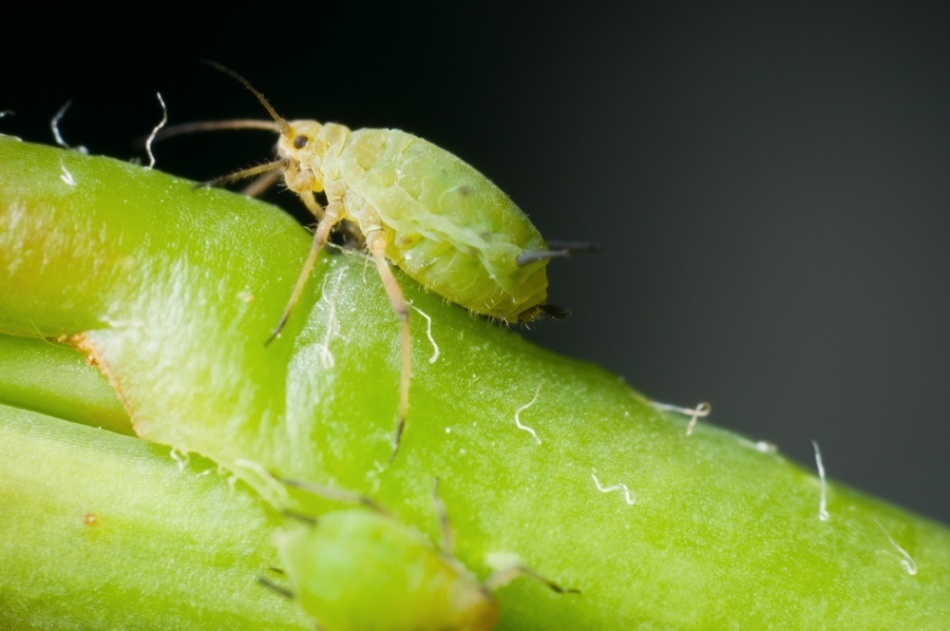 Aphids on pepper sprouts
Aphids on pepper sprouts Chemical methods for the destruction of aphids:
- Soap solution .In water, dilute the ground soap( 5 - 10 g of soap per 1 liter of water) and carefully spray the seedlings. If there are not many seedlings, it is better to manually rub the affected leaves and stems. Do the procedure 3 - 4 days in a row.
- If the seedlings are out of the living area, treatment with ( Carbofos, Tanrek, Keltan) will be effective. The drug is dissolved in water( 1 tablespoon per 10 liters) and treated with a solution of the plant.
IMPORTANT: Chemical agents for the destruction of aphids should not be used during the flowering and fructification of pepper.
Traditional methods:
Coniferous infusion .Pine or spruce needles( 300 gr.) Pour cold water( 1 liter.) And leave for a week in a dark place. Received infusion, treat infected plants.
 Needles for the preparation of coniferous infusion
Needles for the preparation of coniferous infusion Garlic infusion .A large bulb of garlic, mash until the formation of gruel, pour warm water( 3 liters.) And leave to infuse in a dark place for a day. Then sprinkle abundantly with paprika seedling.
Soap, oil and garlic solution . Ingredients:
- Purified medium sized garlic cloves( 7 pcs.)
- Vegetable oil( 10 ml)
- Liquid soap( 5 ml)
- Water( 0.5 L)
Preparation:
- Crush garlic and pour with water
- Leave in a dark place for 3 days
- Strain
- Add liquid and soap
- to the liquid. Mix
- . Before using, dilute the product with water in the ratio 1:10
- Apply for seedling treatment 3 - 4 days in a row
Solutionfrom ashes, tobacco dust and soap. Ingredients:
- Wood Ash( 50 g.)
- Tobacco dust( 50 g)
- Water( 2 l.)
- Liquid soap( 2 items of lye)
Preparation:
- Pour in a mixture of ash and tobacco dust
- Mix with
- Leave to infusefor 4 days
- Filter
- Add liquid liquid soap
- to the resulting liquid. Mix
- Handle the aphid accumulation sites
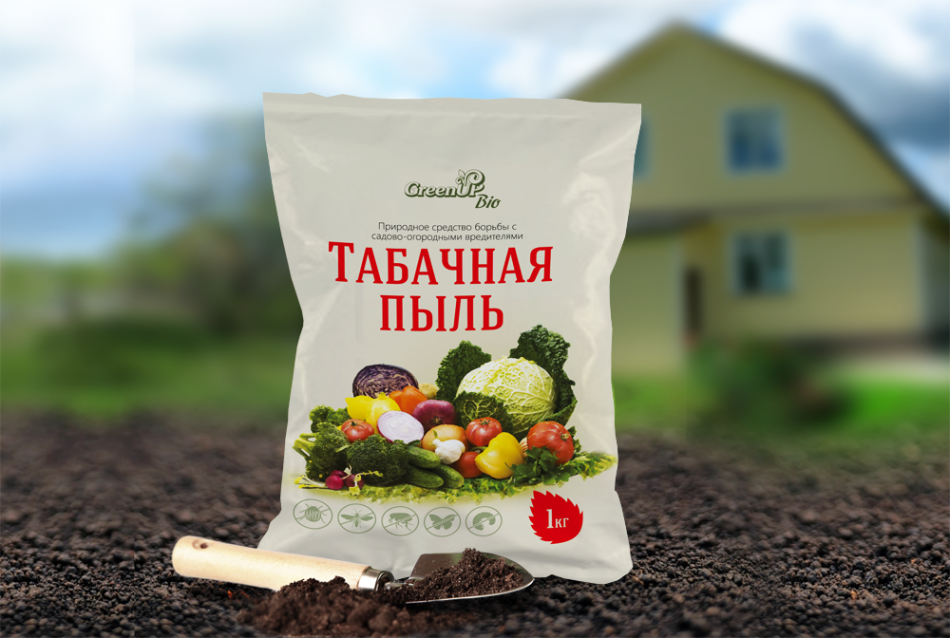 Tobacco dust for killing
Tobacco dust for killing Why do the leaves yellow in the seedling of peppers: what to do?
There are several reasons for the yellowing of the leaves in seedling peppers:
- Low air temperature. Pepper is very sensitive to a drop in temperature. If the plants are already planted in the ground, and the night temperature drops below + 15 ° C, the pepper will freeze and become sick. The first signs of frostbite are the yellowing of the leaves. Then they fall off, and the plants die. The most comfortable pepper seedling feels at a temperature of +22 ° C.Therefore, you do not need to hurry to plant the seedlings in the spring on the beds until the temperature is established.
- Insufficient or irregular watering. If you water the pepper less often than 1 time in 5 days, or use water for irrigation, the root system is not fully developed. However, overflowing is not less dangerous for pepper sprouts. Excessive moisture leads to stagnation of water and decay of plants.
- Transplant .Often pepper seedling turns yellow after transplanting into the ground. This is due to the fact that the roots released from the close capacity begin to grow rapidly, taking away the food from the stems and leaves. It is necessary to transplant an unfermented pepper seedling with a small root.
- Pests bite the roots of .If the roots of the plant are attacked by underground pests, this will necessarily affect the condition of the leaves. To save plants can only fight with insects and rodents. Lack of nitrogen .With a lack of nitrogen in the soil, a specific yellowing of pepper seedlings occurs. Starting from the lowest, the yellowness gradually covers the nearby upper leaves. The situation can be saved by timely fertilizing of plants.
- Plants with too long intertwined roots. If the roots do not spread out during transplantation, the feeding process will be disturbed and the root system will gradually die off.
- Fusarium is a disease in which the leaves of the pepper become bright yellow, blackened streaks are visible on the stalk sections. Sick plants should be torn out and destroyed. Left to provide moderate watering.
Video: Why do the leaves turn yellow in pepper seedlings?
IMPORTANT: If the leaves of the pepper seedling pale and turn yellow from below - there is not enough nitrogen, potassium or phosphorus in the soil. Yellowing of the upper young leaves indicates a lack of iron and zinc. When all the leaves turn yellow at the edges and are twisted at the same time, there is not enough potassium.
 Yellow leaves in pepper seedlings
Yellow leaves in pepper seedlings Twist leaves in pepper seedlings
Twisting of leaves in pepper seedlings can occur for three reasons:
- The leaves are affected by a mite or aphid, or the roots of seedlings are gnawed by underground harmful insects. Before planting pepper, the soil must be treated with a solution of potassium permanganate, pour steep boiling water or bake in the oven. Such treatment will kill the larvae of harmful insects.
- Potassium deficiency in the soil. It is necessary as soon as possible to feed plants with potassium nitrate or ash. Ash should cover the surface of the soil with a layer of 2 - 3 mm.
- Non-uniform growth of sheet - the central part grows faster than the edges. Therefore, in the lagging part, the fox twists and contracts. Do not need anything, soon this process will be normalized.
IMPORTANT: The reason for twisting the leaves of pepper seedlings may also be a reaction to a transplant, insufficient watering, dry and hot or too cold air. In these cases, the twisted leaves look sluggish.
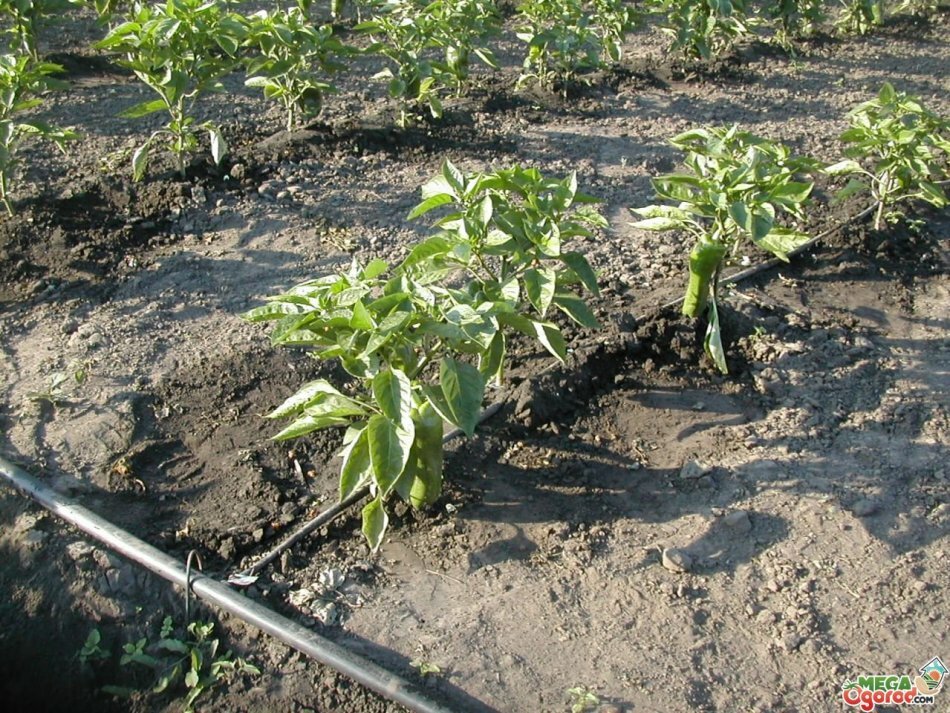 Leaves of pepper seedlings are twisted due to insufficient irrigation
Leaves of pepper seedlings are twisted due to insufficient irrigation Why do paprika seedlings have fallen leaves?
Falling of the lowest cotyledonous leaves in pepper seedlings is a normal process and should not cause concern.
This can occur for the following reasons:
- over-dried primer
- excessive watering
- seedlings not thinned, it is tight
- pest attack
- recently dived
- in the ground insufficiently minerals
- high concentration of fertilizers
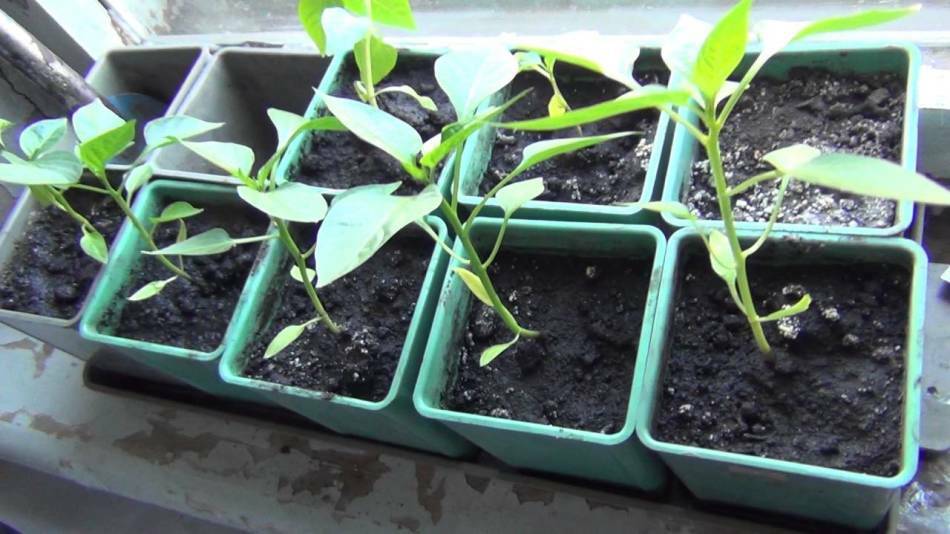 Pepper seedlings fall leaves
Pepper seedlings fall leaves Video: Growing pepper. Why does the pepper fall leaves and flowers? Spider mite and root rot.
Video: Seedling of peppers. How to prevent falling of leaves?
Why does not the sprouting of sweet pepper grow or grow poorly?
Slow or insufficient growth of seedlings is one of the most common problems that growers face when growing sweet peppers. Why pepper does not want to grow?
- The most common cause of poor growth of pepper seedlings is the low or too high air temperature .The capriciousness and heat-loving nature of this plant are its drawbacks, and it is not always possible to provide the seedlings with a suitable temperature. Therefore it is necessary to put up with some lagging behind of young plants in growth until the temperature on the street is established. If in a greenhouse, on the contrary, it is too hot( 30 ° C and above), regular airing is necessary.
- The temperature and amount of water can also affect the growth of pepper seedlings. Watering plants should be done regularly, sufficiently moistening the soil, standing water at room temperature. In this case, the morning watering under the roots is preferable.
- Lack or excess nitrogen in the soil. Pepper grows poorly there, where nitrogen is not enough, but even with its excess in the soil it feels very bad. Especially the overabundance of nitrogen affects the growth of leaves and fruits.
- If the lag of pepper seedlings in the growth of is accompanied by wilting, most likely the plants are infected with a bacterial infection of .In this case, it will be very difficult to save seedlings. It must be urgently removed from healthy plants to avoid the spread of infection.
- Incorrect ( overstated or underestimated) planting plants in the ground or removing "extra" shoots also slows the growth and development of pepper sprouts.
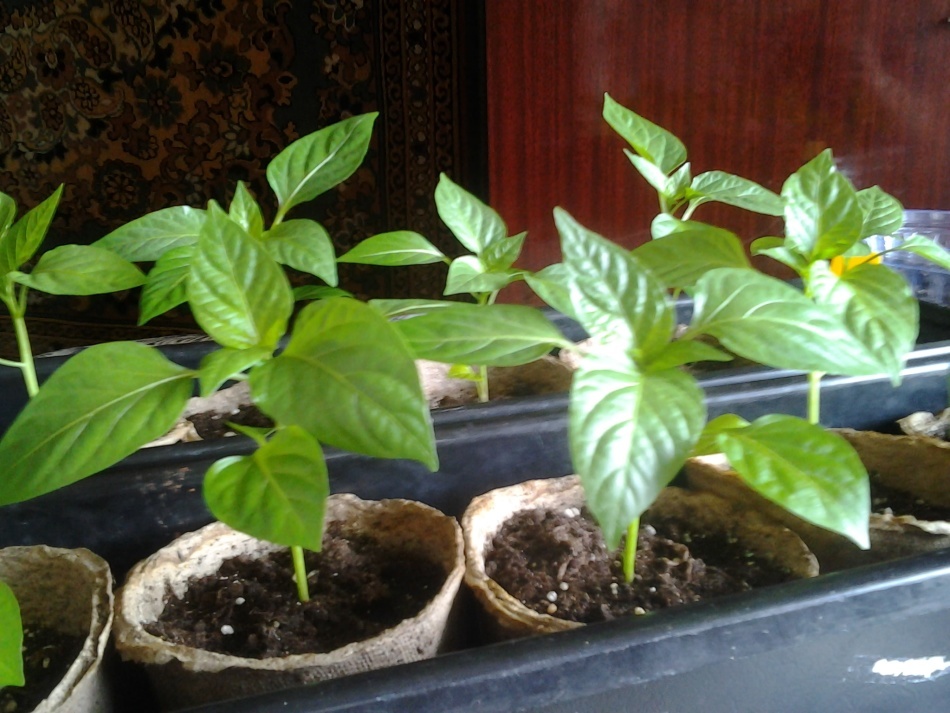 Sweet pepper seedlings grow poorly
Sweet pepper seedlings grow poorly Spider mite on pepper sprouts
A barely noticeable spider mite on pepper sprouts indicates infection of the with a spider mite. During the settlement of these tiny arachnid insects, it is practically impossible to notice, and after 9-14 days from the moment of infection the number of mites increases 200 times. While the colony of ticks is small, the arachnoid plaque is on the underside of the leaves and looks like separate thread spiders. But with an increase in the number of mites, the plaque becomes denser and moves to the front side of the leaves.
IMPORTANT: The damage caused by mites pepper seedlings is very large - they pierce the leaves and suck the juice. As a result, the plant changes color, curls, withers and dries. Under the web, other insect pests such as aphids and whitefly can also live. Conditions created by mites on seedlings are favorable for the life and reproduction of these parasites.
Here is what will help in the fight against a spider mite on pepper seedlings:
- Remove and destroy( burn, deeply drip) damaged leaves
- Treat infected plants with insecticides( Phytoverm, Bitoxibabacillin)
- If previous actions did not help, apply wide spectrum acaricides( Actellik)
IMPORTANT: Prolonged use of acaricides is unacceptable, since they are highly toxic.
To prevent the infection of pepper sprouts, spider mites include:
- timely removal of weed grass
- spraying of soil with lime solution
- planting seedlings of different crops with alternating rows
- regular visual inspection of seedlings
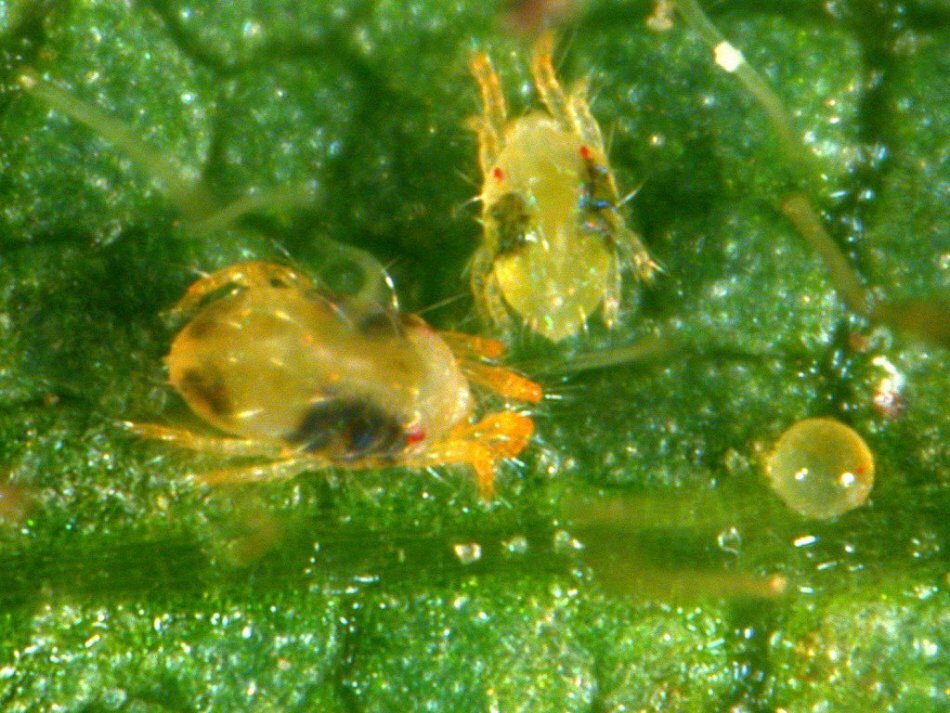 Spider mite on sprouts of pepper
Spider mite on sprouts of pepper Someone eats seedling pepper than to treat?
Before processing the pepper seedling, it is advisable to find out who is eating it. Pests can be ground and underground .Of the ground, significant visible damage to the leaves and young ovary of pepper seedlings can cause to bare slugs.
These pests either gnaw large holes, or completely eat leaves and flowers on pepper seedlings. Slugs come out at night, prefer the most moistened soil. During the daytime "catch" slugs for eating seedlings will not succeed, so guess this pest can only "by handwriting."
For the control of slugs naked use solution of lime or lime and tobacco .They are abundantly watered by ditches around beds with pepper. When loosening, ground bitter pepper and mustard powder are covered. It is also important to regularly ventilate the greenhouse and prevent waterlogging of the soil.
 Seedlings of pepper somebody eats
Seedlings of pepper somebody eats Under the ground pods can sprout seedling can bear( in the people cabbage) .This burrowing insect is 5-7 cm in size with a long velvety brownish calf, a hard shell on its head and powerful forelimbs, it lives in soil rich in humus.
The result of the life of the bears are multiple underground passages and damaged plant roots. If the pepper is seeded under the ground by a bear, damaged plants will soon die. There are many ways to combat the bear. Here are some of them:
- Scare off the teddy bears from the beds with pepper can smells of naphthalene and kerosene.
- Also in the fall for these pests arrange traps .For this, dig holes and fill them with manure. In these traps, insects gather for the winter. With the onset of winter frosts, trap holes are torn, manure is scattered along with sleeping insects. In the cold, the bear quickly die, not having time to wake up and hide. In the warm season, such traps are used to attract the bears building nests. After 2 weeks, the nests are destroyed and the insects found in them are destroyed.
- You can lure a bear from a mink with strong soapy water. It is poured into the detected stroke and poured water from the hose.
- Traps with beer will help catch pests. Banks are buried in the ground in such a way that their necks are at the same level with the earth's surface. Then they pour beer into the cans. Above, the can is covered with boards, leaving a gap in which the bear can crawl. The smell of beer attracts these insects very much, therefore, having arranged several such traps on the bed, it is possible to protect pepper seedlings from damage to the underground part.
- Similarly, makes honey and water traps , but instead of beer poured ordinary water, and the edges of the cans are smeared with honey. Medvedki, come to the smell of honey and, getting into the water, can not get out of the traps.
IMPORTANT: Experienced truck farmers protect pepper seedlings, putting on each plant a kapron stocking just before planting into the ground. Thus, large roots and stems will be under reliable protection.
If there is no desire to catch a bear by folk remedies, you can use poison .The strongest are "Thunder", "Rembek", "Medigon", "Medotoks" and Phenoxin plus ".In each turn, 3-4 granules of the drug are pawned and must be sprinkled with earth.
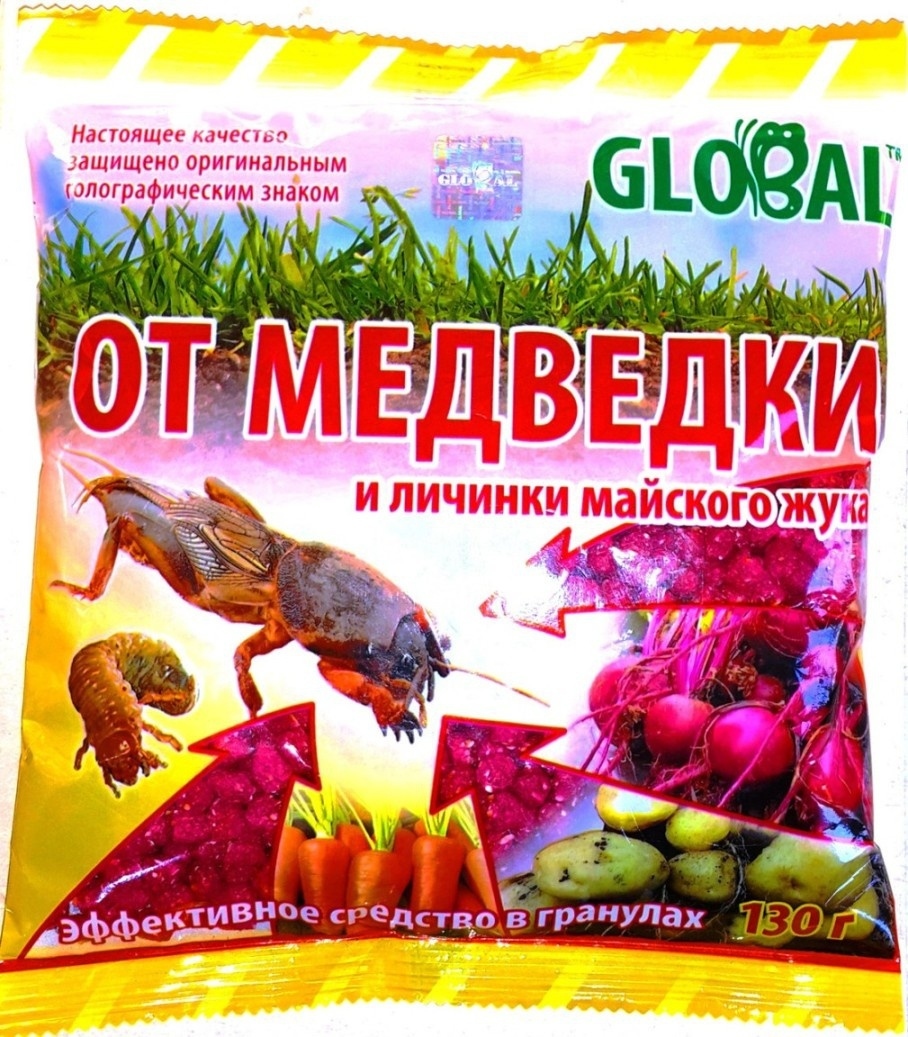 Means for combating the bear
Means for combating the bear IMPORTANT: If the pellets remain on the surface, they can be glued to birds or eat pets.
:
- garlic
- coriander
- onion
- onion
- scent of eggs
- odor of perishable fish
biological products "Nemabakt" and "Boverin" are an effective safe for humans, animals and plants to destroy the bear on the site. Eating these funds, insects are infected with a predatory nematode in the first case and spores of fungi in the second. Parasitization in the body of these microorganisms leads to imminent imminent death of the bears.
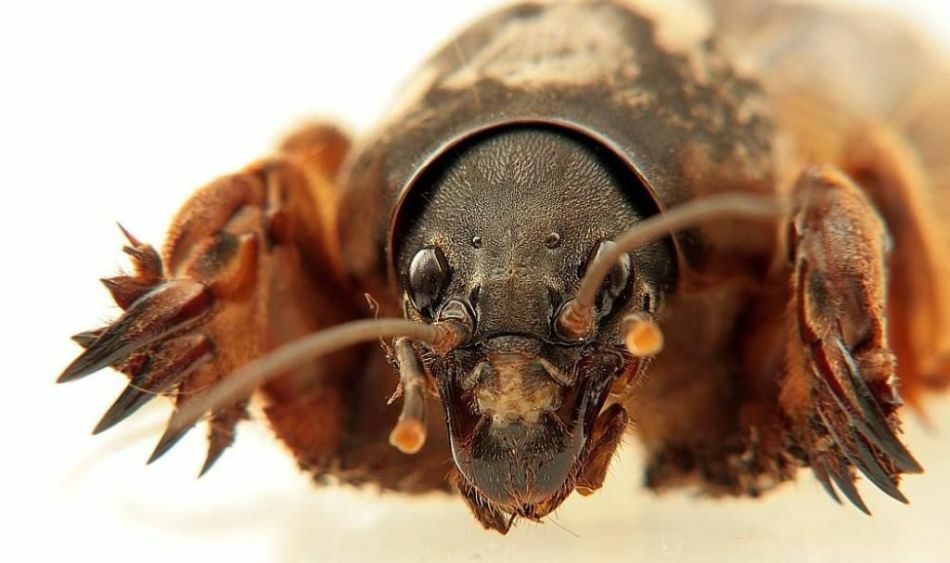 The bear is eating up the roots of pepper sprouts
The bear is eating up the roots of pepper sprouts Pimples
appeared on seedling peppers Pimples on the foliage of pepper seedlings can be formed for several reasons:
- Oedema - swelling of leaves due to lack of light in excess of moisture. To save the situation will be the reduction of watering and ensuring greater access of sun rays to pepper seedlings.
- Spider mite .In this case, the appearance of pimples indicates an initial stage of infection. It is necessary to treat seedlings from spider mites.
- Aphids or scabbard .When infecting these small parasites on the leaves, there will be a specific sticky coating - the release of insects. The treatment with Confondor, Carbophos, Aktara or soap and ammonia solution will help.
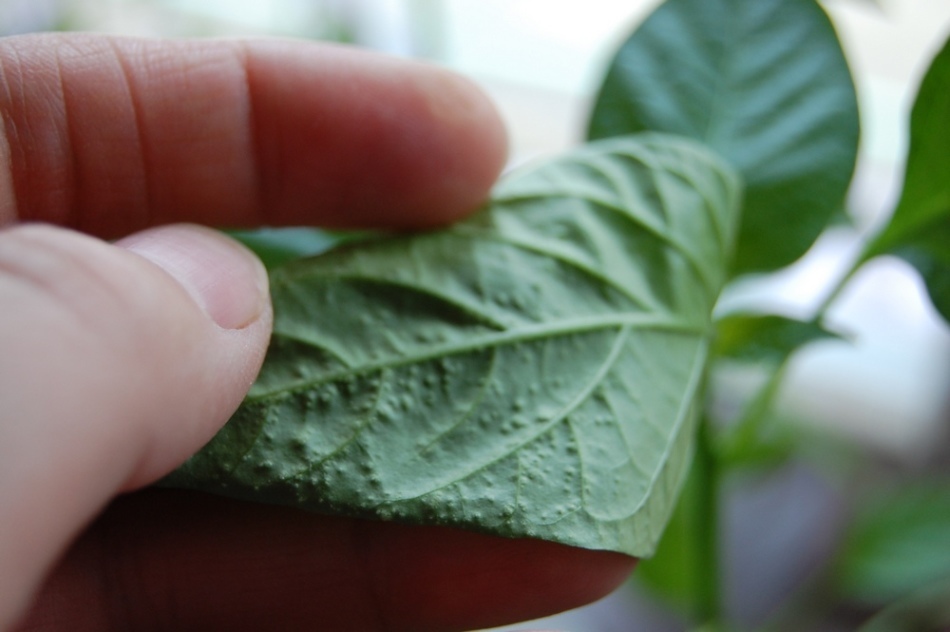 Pimples appeared on seedlings of peppers
Pimples appeared on seedlings of peppers Pepper sprouts
withers. The situation when yesterday the healthy young plants of pepper seedlings suddenly began to lower lifeless leaves and lean towards the ground, extremely unpleasant and often incomprehensible.
The decay of the pepper seedlings may occur for the following reasons:
- in the room the air
- is air-dried in the place where the seedlings are standing, the
- draft "walks" in the pond or in the ground, the water stagnant, and the harmful bacteria
- become littered with the drainage system and, as a consequence,root decay
- poor quality
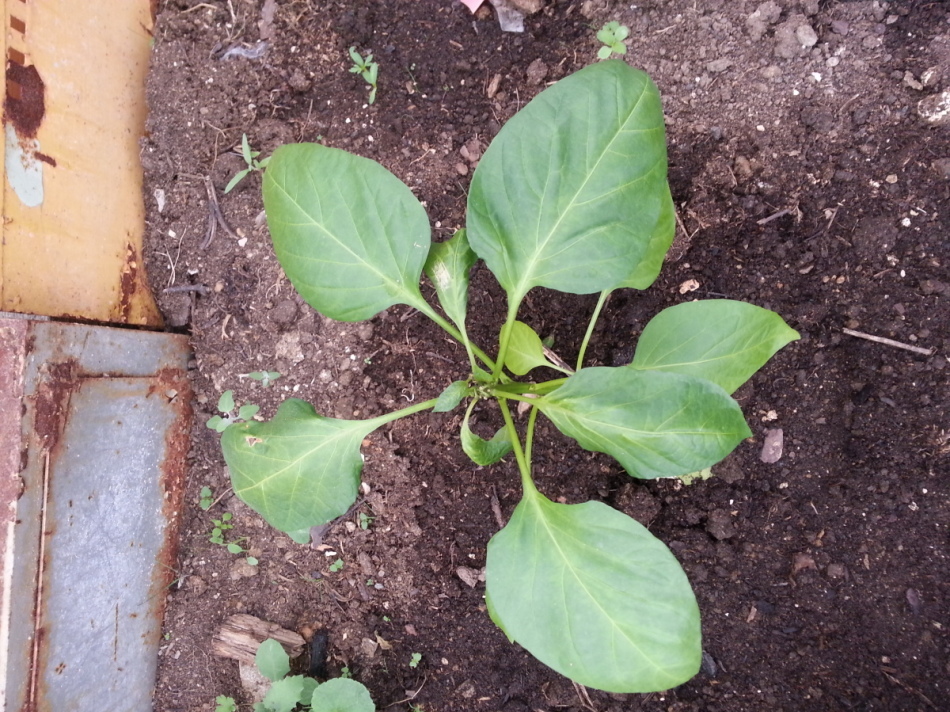 Paddy seedling
Paddy seedling Black leg of pepper seed
Black leg is a fungal disease that affects many vegetable crops at the stage of growing seedlings. Pepper was no exception. The black leg appears sharply, spreads immediately over all the plants and rapidly leads to their death.
IMPORTANT: Pathogens persist for a long time in the ground.
Visually, the disease can be recognized by thinning and blackening the stems of diseased plants in the basal area. At the same time, the leaves curl or turn yellow, and the plants themselves can be pulled out of the soil without effort.
Reasons for the appearance of the black leg:
- acid soil
- lack of timely picking
- thick seeding
- lack of light
- excess of moisture
- low air temperature
- poor ventilation
IMPORTANT: The combination of all or several factors leads to the maximum rapid spread of the disease.
Anti-blackstalk control measures:
- antibacterial soil treatment
- creation of normal conditions for seedling growth( lighting, temperature and humidity, irrigation)
- regular airing of greenhouses and greenhouses
- sanding under the roots with a layer of 1.5 - 2 cm
- removal and destructionsick plants together with soil and neighboring healthy plants
IMPORTANT: It is extremely rare for a black leg to infect seedlings grown in peat pots. Therefore, it is this way recommended to grow seedlings of peppers experienced farmers.
 Black leg
Black leg Whitefly on the pepper sprouts
Greenhouse( greenhouse) whitefly - the smallest insect pest affecting vegetable seedlings in greenhouses and greenhouses. Whitefly sucks the juice from the greens, while leaving on the stems and leaves of seedling pepper a sticky coating in which the pathogenic fungi multiply rapidly.
The whitefly is settling in dry and warm rooms, therefore regular airing and moistening of air and soil is the prevention of infection.
IMPORTANT: If the white-winged seedlings are not rescued in time, it will die soon, as the parasitic insects reproduce very quickly, leaving a lot of clutches directly on the leaves.
 Whitefly colonies attack
Whitefly colonies attack seedlings. If a whitefly is found, the damaged plants should be carefully treated with with garlic infusion .
To prepare it you will need:
- peeled garlic cloves( 2 items)
- water( 1l)
- glass jar with lid
Preparation:
- Rub garlic on a fine grater or pass through a meat grinder
- Put the mass in a glass jar
- Pour with water, cover
- Leave for 5 days in a dark place.
- For spraying seedlings, take 1 - 1.5 tsp.infusion and dilute in 1 liter of water. You can use a spray or wipe the leaves and stems with a sponge soaked in a solution.
Also whitefly can be easily defeated with the help of chemical means, such as "Admiral", "Aktara", "Commander", "Oberon".
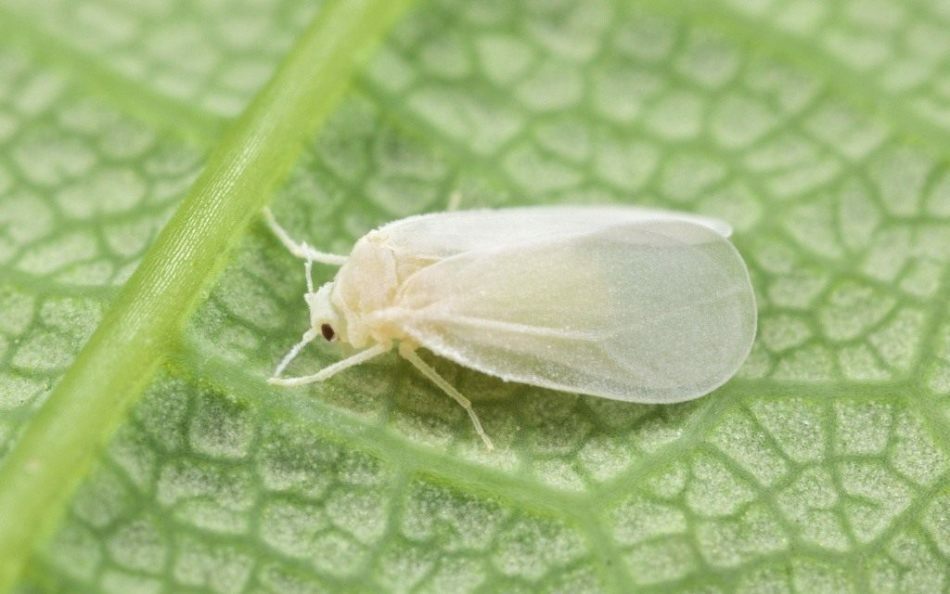 Whitefly on the pepper sprouts
Whitefly on the pepper sprouts White coating on the leaves of the pepper sprouts
White coating on the back of the leaves of the pepper seedlings, combined with their deformation and the formation of whitish spots indicates powdery mildew infestation. If detected, it is necessary to urgently treat the plants with any systemic fungicide, otherwise the seedlings will die.
A white fluffy coating on the lower leaves and the root portion of the stems may indicate that the plants are infected with sclerotinosis( white rot).The affected places are covered with charcoal or chalk.
A cobweb-like white coating on the leaves of speaks of infection with a spider mite.
What should I do if the pepper seedlings are stretched?
Seedlings can stretch in such cases:
- lack of light
- early seeding
- overexposure
- later thinning
- excessive watering and high temperature
If the pepper seedling is too stretched out, the truck farmer will have nothing else but to gently transplant her to the bed and take care. It is possible for a while to organize delicate fragile plants of supports from sticks and garters. When the pepper gets sick and gets stronger after the transplant, the supports can be removed.
IMPORTANT: Unlike tomato seedlings, no additional roots are formed on the pepper plants. Therefore, it is impossible to plant peppers, laying a long stalk in a spiral, or to divide one plant into several and try to root them.
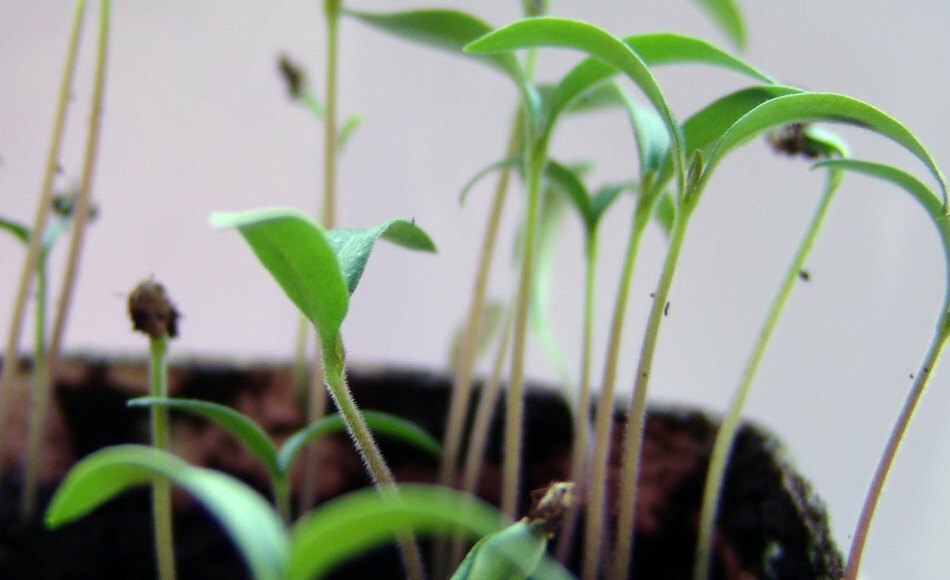 Sprouted seedling pepper
Sprouted seedling pepper How to treat pepper seedlings from pests?
To protect against pests, you can treat pepper seedlings with any universal chemical.
Video: Peppers. We treat from pests
The best prevention of damage to young pepper plants by insects is observance of the technology of growing seedlings. If, during cultivation, you can ensure good ventilation, normal humidity and regular watering, diseases and pests will bypass your garden with a side, and a rich harvest will be a reward for the efforts made.
